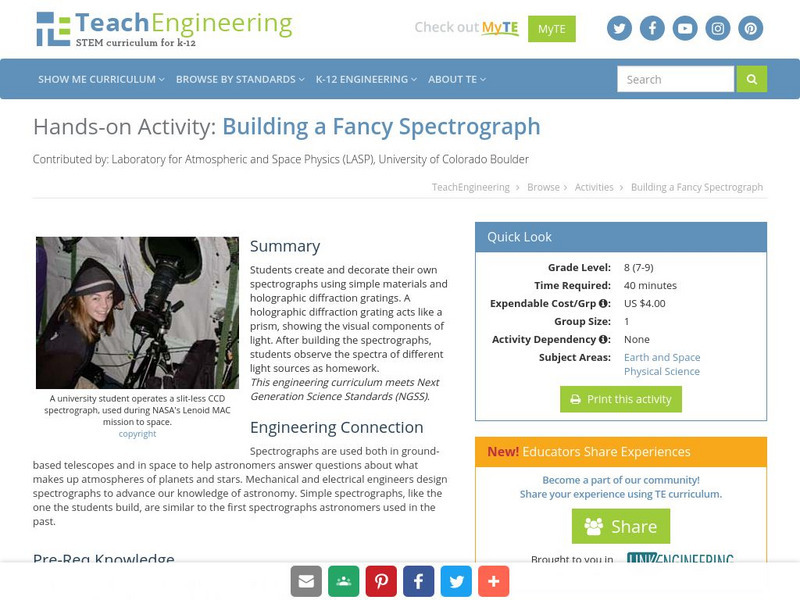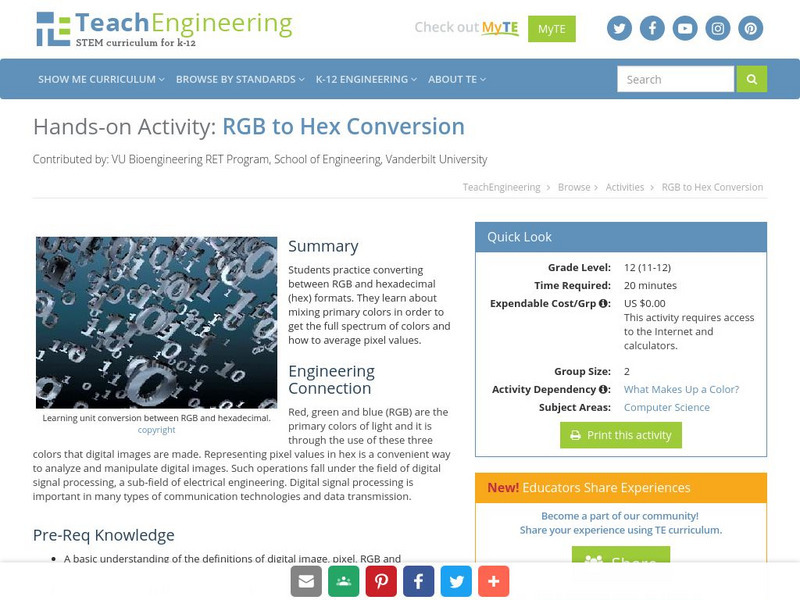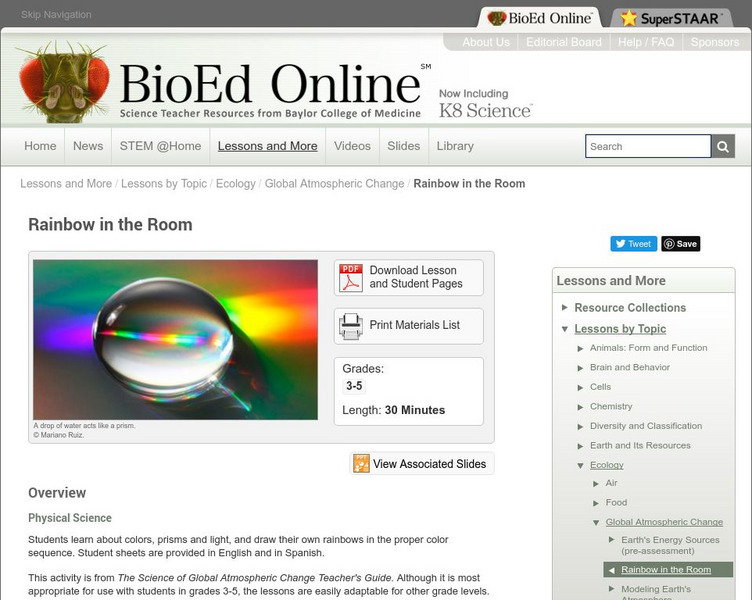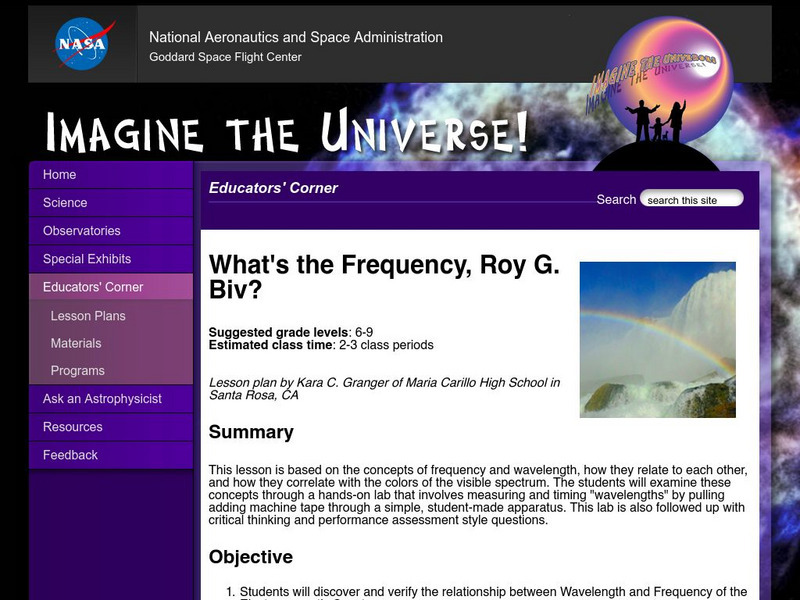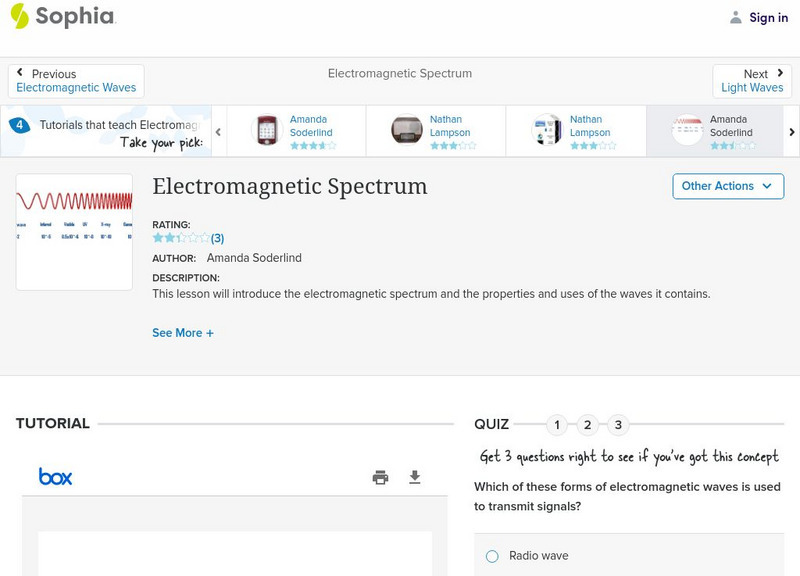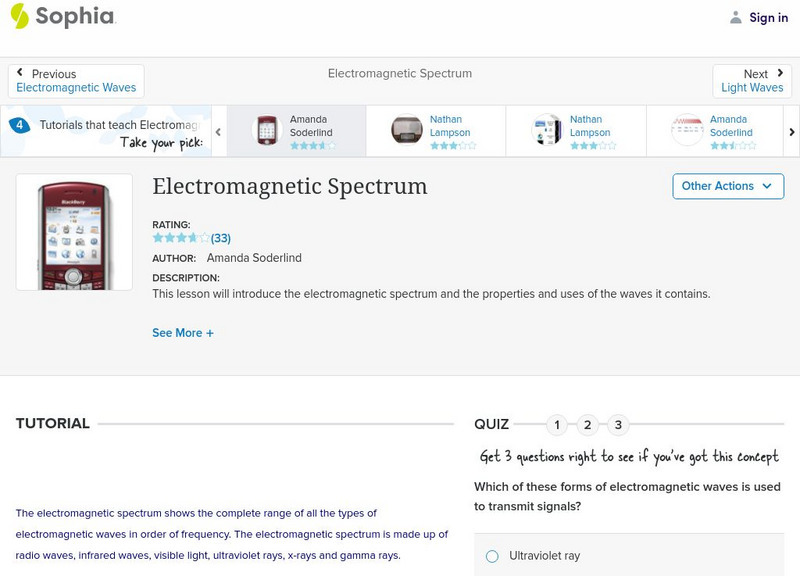Hi, what do you want to do?
Sophia Learning
Sophia: Light Waves: Lesson 1
This lesson will introduce light waves and describe how a particle can travel as a photon or a wave. It is 1 of 4 in the series titled "Light Waves."
Sophia Learning
Sophia: Light Waves: Lesson 3
This lesson will introduce light waves and describe how a particle can travel as a photon or a wave. It is 3 of 4 in the series titled "Light Waves."
Exploratorium
Exploratorium: Science Snacks: Cd Spectroscope
Analyze light by creating a CD spectroscope in this activity. See the whole spectrum of light with the spectroscope.
Physics Classroom
The Physics Classroom: The Electromagnetic and Visible Spectra
A tutorial on the electromagnetic and visible spectra. Discusses dispersion and how perceptions of white and black are related to the visible light spectrum.
Khan Academy
Khan Academy: Understanding Spectra
This is an 8-problem quiz/practice to increase students' understanding of spectra. Color is a property of light. Test your understanding of this concept and how light can be represented in with a spectral power distribution.
TeachEngineering
Teach Engineering: Building a Fancy Spectrograph
Students create and decorate their own spectrographs using simple materials and holographic diffraction gratings. A holographic diffraction grating acts like a prism, showing the visual components of light. After building the...
TeachEngineering
Teach Engineering: Rgb to Hex Conversion
Students practice converting between RGB and hexadecimal (hex) formats. They learn about mixing primary colors in order to get the full spectrum of colors and how to average pixel values.
Science Struck
Science Struck: Emission Spectrum vs. Absorption Spectrum
Explains the difference between an emission spectrum and an absorption spectrum, and describes each as well as their applications.
Physics Classroom
The Physics Classroom: Light Waves and Color: Blue Skies and Red Sunsets
Students will focus on the interaction of sunlight with atmospheric particles to produce blue skies and red sunsets.
Georgia State University
Georgia State University: Hyper Physics: Scattering Concepts
A collection of several pages explaining the principles which underlie Rayleigh scattering of light.
BioEd Online
Bio Ed Online: Rainbow in the Room
Students investigate the properties of visible light and the sequence of colors in the spectrum using light shone through water and prisms. The lesson and accompanying slideshow can both be downloaded.
Vision Learning
Visionlearning: Physics: Light Ii: Electromagnetism
Instructional module focusing on light and electromagnetism. Discussion includes historical discoveries that led to the understanding of the electromagnetic spectrum. Site also includes an interactive practice quiz and links relating to...
Khan Academy
Khan Academy: Light: Electromagnetic Waves, Electromagnetic Spectrum and Photons
This article discusses the properties of electromagnetic radiation and photons.
Other
Fluorescent Mineral Society: The Ultraviolet Spectrum
This resource presents a discussion of the nature and properties of ultraviolet light. The manner in which minerals emit UV light is described and explained.
NASA
Nasa: Imagine the Universe: What's the Frequency, Roy G. Biv
In this very detailed lesson plan from NASA, students investigate wavelength and frequency within the electromagnetic spectrum.
Space Telescope Science Institute
Amazing Space: Star Light, Star Bright
An online exploration where students learn the basics about light and the properties of waves and the electromagnetic spectrum. Students will also learn how to measure wavelength and frequency so they can understand the electromagnetic...
Space Telescope Science Institute
Amazing Space: Star Light Star Bright
Learn all about stars and the electromagnetic spectrum in this series of activities.
Space Telescope Science Institute
Amazing Space: Star Light Star Bright: Electromagnetic Radiation
Use this tool to learn facts about the range of the electromagnetic spectrum, from radio waves to gamma rays.
CK-12 Foundation
Ck 12: Earth Science: Study of Space by the Electromagnetic Spectrum
[Free Registration/Login may be required to access all resource tools.] Overview of the electromagnetic spectrum.
TED Talks
Ted: Ted Ed: Light Waves, Visible and Invisible
Lucianne Walkowicz shows us the waves just beyond our perception: microwaves, radio waves, x-rays and more. [5:58]
Sophia Learning
Sophia: Electromagnetic Spectrum: Lesson 2
This lesson will introduce the electromagnetic spectrum and the properties and uses of the waves it contains. It is 2 of 4 in the series titled "Electromagnetic Spectrum."
Sophia Learning
Sophia: Electromagnetic Spectrum: Lesson 3
This lesson will introduce the electromagnetic spectrum and the properties and uses of the waves it contains. It is 3 of 4 in the series titled "Electromagnetic Spectrum."
Sophia Learning
Sophia: Electromagnetic Spectrum: Lesson 4
This lesson will introduce the electromagnetic spectrum and the properties and uses of the waves it contains. It is 4 of 4 in the series titled "Electromagnetic Spectrum."
Sophia Learning
Sophia: Electromagnetic Spectrum: Lesson 1
This lesson will introduce the electromagnetic spectrum and the properties and uses of the waves it contains. It is 1 of 4 in the series titled "Electromagnetic Spectrum."










